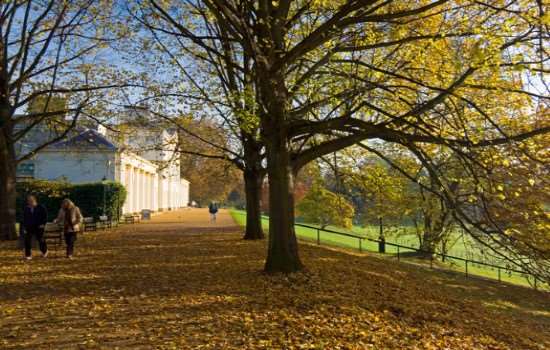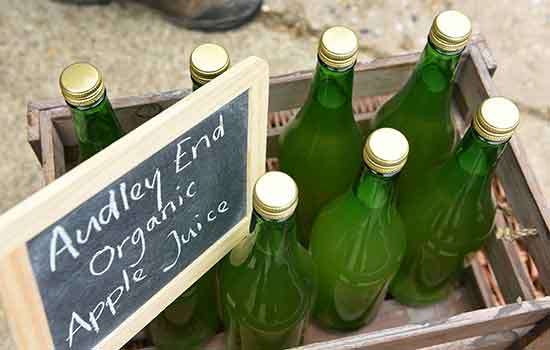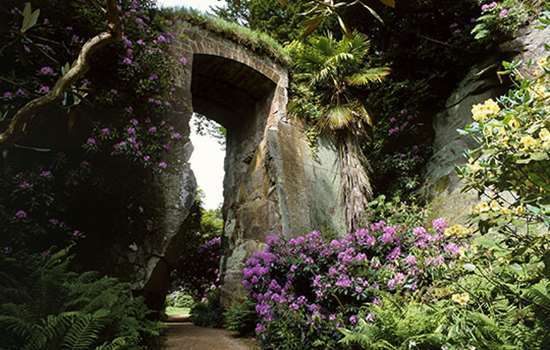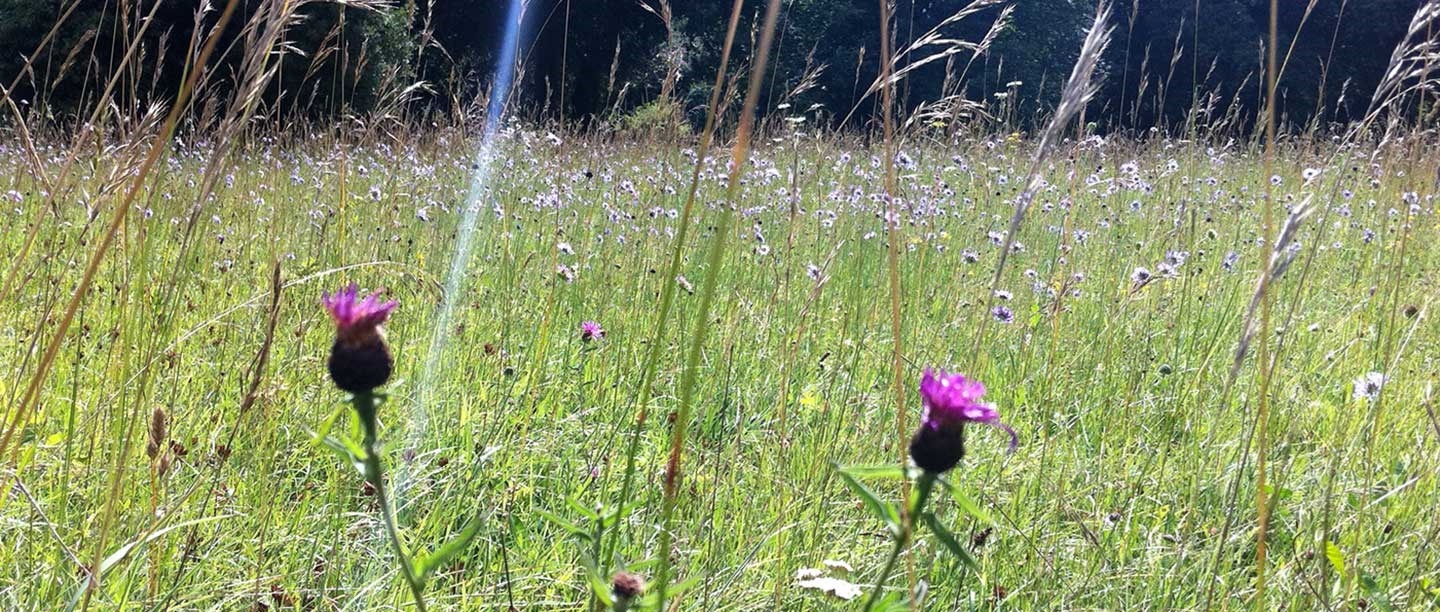A threatened habitat
The swathes of meadow that would have been seen in English landscapes in the past have now been lost to widespread modern and intensive farming and horticultural practices.
This includes historic treatments of heritage sites. When English Heritage inherited the Ministry of Works sites in 1983, many were dominated by a municipal approach to their presentation, with tightly clipped grass and edged lawns.
It was important to restore these to their former glory to support and conserve these biodiverse habitats, and to remain true to the historic practices and appearances unique to meadows.
In fact, while some of the tools and equipment for managing grasslands and meadows have developed since Victorian times, the basics are little changed. No matter the techniques, the basic aim is to suppress the vigorous growth of certain grasses whilst supporting the spread of wildflowers, and to assist in the introduction of new species. This is done by controlling and reducing the level of nutrients in the grass and soil.
100 Meadows across 100 historic sites
To celebrate the coronation of His Majesty King Charles III in 2023, we are creating and enhancing 100 meadows at our castles and abbeys, prehistoric stone circles and palaces.
Over the next decade English Heritage – working with Plantlife – will create a natural legacy at 100 of our historic sites, establishing flower-rich grasslands right across England. From Stonehenge on Salisbury Plain to the Jewel Tower in the heart of Westminster, we will be reviving natural meadows which have been lost, and revitalising those that already exist.
Read moreTraditional methods
At some of our sites, the summer-flowering meadows are managed in a traditional way by harvesting hay crops and being used over the winter for sheep grazing. It’s not only for convenience that meadows are used to graze animals. Their droppings can disseminate seeds from the plants they have consumed, and their hooves create indentations in the ground for new wildflower seeds to establish in the spring.
Meadow management requires skill and experience. For example, it’s essential to judge the best time for a hay cut so as to ensure that the majority of wildflower seeds have ripened and will be left in the meadow and not removed in the hay.
It’s generally accepted that mid-July is the earliest time that seeds will have ripened in much of the UK, but this varies according to the types of species within the meadow and weather conditions each year. A practiced eye is essential to weigh up the options; for example, later cuts in late August and early September can also benefit a variety of useful meadow insect life, enabling them to have completed their life cycles.
Harvesting the West Meadow at Kenwood House
Skilled English Heritage gardeners, including Paul Jackson, Head Gardener at Kenwood House, closely manage our precious meadows. Here, he explains the process of harvesting a Kenwood House meadow for hay - and the value of this habitat to wildlife including butterflies.
Visit KenwoodA home for rare species
The drama of our meadows’ swaying grass (particularly in rugged, windswept locations) is not the only advantage of their conservation. They create vital habitats for flora and fauna, including rare and endangered species.
This includes a whole range of butterfly species, including some that are threatened in the UK. These include the White Letter Hairstreak, which you can see at Roche and Haughmond abbeys amongst others, and the Glanville Fritillary at Hurst and Carisbrooke castles. Many, many of our places offer up chances to see instantly recognisable species such as the iconic Painted Lady and Red Admiral (pictured here).
Some of our sites include also areas of SSSI, sites of specific scientific interest, which means that they are protected by law to conserve them. One such example is prehistoric Grimes Graves, which has rare low lying acid grassland.
Some of our historic meadows
Marble Hill Meadow
Meadows are a significant part of the historic landscape at Marble Hill, London, and were present long before the house was built for Henrietta Howard in the 1720s. A map of 1711 shows meadows to the south of the area near the Thames, where flooding would have improved the soils. Areas of the park are still known today as West Meadow and East Meadow.
As part of a Heritage Lottery Fund project wildflower meadows were enhanced and extended in these areas, continuing the historic management of the landscape. In July 2020, Marble Hill took delivery of a boatload of freshly-cut hay from the National Trust’s Ham House, from the other side of the River Thames. The fresh hay, which was then spread on site at Marble Hill, was full of the seeds of wildflowers and meadow grasses which had been left to grow and flower through the spring and early summer before it was cut.
Using Ham House’s meadows as a ‘donor site’ ensured the additions to Marble Hill’s wildflower meadows were locally sourced and appropriate for the site as the species are naturally present in the local area, and better adapted to local conditions.
Visit Marble Hill
Osborne House meadow
Prince Albert created this one acre meadow, documented through time as a place where wildflowers grew and the royal children played.
It was established in 1850 when the prince created a garden for his children in a clearing identified in 1841 as ‘Little Down’. The royals used this green space in many ways; for example, there are references in Queen Victoria’s journal to the family picking wildflowers, particularly primroses. The royal children would also have collected butterflies for their natural history collection and kept pets in the meadow, including their pet lamb, garden donkey and angora rabbits. These were housed in hutches in the meadow in 1891; their fur was used by Princess Beatrice for spinning and weaving into objects she donated to charity bazaars.
The early 20th century saw the meadow planted with many more trees, and a fountain was installed in its centre in 1907. Around this time we see remarks about the number of orchids, showing how diverse the plant life must have been.
It remains spectacular in spring, with many primroses (Primula vulgaris) and bluebells (Hyacinthoides non-scripta) flowering early in the year with common spotted orchids (Dactyloryza fuchsii), ox-eye daisies (Leucanthemum vulgare) and common knapweed (Centaurea nigra) taking over as the summer progresses.
Visit Osborne
Down House meadow
Darwin used his meadow to produce hay, for grazing his cows, horses and donkey and as a place for observation and experiments. It was in the Great House Meadow where he conducted his very first field experiment, monitoring a layer of chalk and cinders over several years to see how much the hidden motion of earthworms caused them to sink. This layer of particles, buried beneath the soil’s surface, is still identifiable today.
Darwin's experiments spread to a wider landscape and in 1855, with the help of the children's governess, he started a survey of all flowering plant species growing in the neighbouring Great Pucklands Meadow. He would go on to use the data to demonstrate biodiversity in his seminal work on natural selection. 150 years on, the same survey was repeated by botanists from the Natural History Museum, local naturalists and volunteers, giving similar results.
Today, both meadows provide an outstanding show in the early summer. Buttercups turn the field into a golden blaze, followed by white and red clover, great burnet, ox-eye daisies, knapweed and many more. This wonderful array is enjoyed by visitors large and small, and including bees, butterflies, moths, wasps.
Visit Down House
Butterflies in our gardens
Our gardens offer a habitat for a huge range of species, including some rare or endangered butterflies. These wonderful pictures were captured by a staff member in the extensive grounds of Brodsworth Hall and Gardens.
Explore more of the work we do in historic gardens
-

Seasonal gardens at Kenwood House
Kenwood may see us making hay in the meadows during the summer, but each season brings changes to the gardens and landscapes. Read more about Kenwood through the seasons.
-

Traditional gardening methods
Read a blog post about ways we use and update traditional methods in our gardens - here, using modern organic methods in the Victorian kitchen gardens at Audley End House.
-

Explore more of our historic gardens
English Heritage looks after many historic gardens and landscapes across the country. Explore more to plan a visit to see traditional orchards, more meadows or Tudor splendour!
